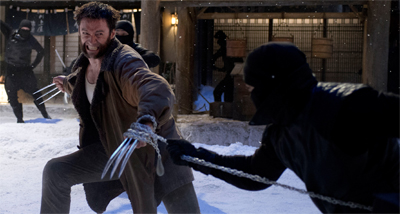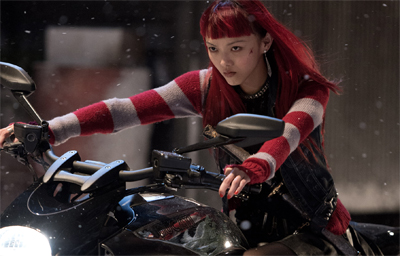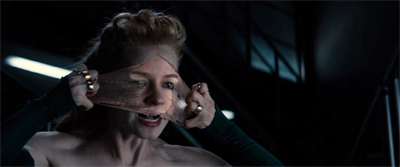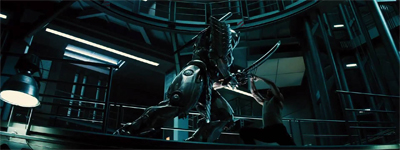The Wolverine is pretty far from a perfect film. In the era following The Dark Knight, we’ve come to expect more ambition from our superhero blockbusters; tighter plots; well-drawn character arcs and motivations for more than just our heroes. In a summer where some have fallen just short of working within this new paradigm (Man of Steel) and others have succeeded (Iron Man 3), The Wolverine feels like a conscious throwback. It’s a nineties action movie masquerading as a superhero blockbuster. Had it been released in 2007, it would have been well-received.
And yet, there’s something quite fascinating and compelling about The Wolverine, despite the noticeable problems with the script’s third act. Director James Mangold struggles to keep things under control for as long as possible, Hugh Jackman still has a wonderful charm in the eponymous role, and The Wolverine has a fascinating thematic through-line and an approach to inter-movie continuity which is intriguing and strangely satisfying.
The Wolverine falls short of greatness, but it’s still a fun and enjoyable ride.
Interestingly, director James Mangold’s film leans rather heavily on the two worst-received X-Men films. There are constant and heavily allusions to the climax of X-Men III, with the events of that blockbuster serving as character motivation for Logan. A few familiar faces may or may not show up to enforce the link. While director Matthew Vaughn ignored the film in crafting his superior prequel X-Men: First Class, The Wolverine seems to try to reconcile the contrary events of X-Men III, X-Men: First Class and X-Men Origins: Wolverine.
It’s an intriguing approach to continuity, and arguably far more invested than anything Marvel has attempted. Marvel Studios get a lot of credit for their crafting of a gigantic shared universe, but the films don’t always seem to flow smoothly into one another. There are characters and concepts that are shared, but writer/director Joss Whedon was quite happy to ignore the aspects of Kenneth Branagh’s Thor which didn’t fit with his vision of The Avengers. Indeed, the emotional cliffhanger of Thor (how will Thor see Jane again?) is handled with a clunky line or two of exposition (Dad will send him to Earth, but he won’t look her up).
The Wolverine commits to the idea that Fox’s X-Men films form a single shared continuity. This isn’t exactly true, but The Wolverine draws in broad enough strokes that it works. You can see The Wolverine laying the ground work for a shared movie universe quite similar to that at Marvel, and it amounts to more than just one of those post-credit sequences that viewers have come to take for granted since the original Iron Man.
Quite simply, and most fascinatingly, The Wolverine serves as something of a bookend. It’s a very clever piece of structuring – realising that the original Singer/Ratner X-Men trilogy is sandwiched between two Wolverine films. As such, those movies serve as bookends to the original films. While Mangold inherits his character motivation from X-Men III, his film isn’t firmly anchored to the disappointingly bland X-Men Origins: Wolverine. Rather than relying on overlapping plot points, The Wolverine settles for thematic resonance.
After all, continuity minutiae is the recourse of the hardcore fanatic. Who cares how Magneto and Xavier could have recruits Jean as Ian McKellen and Patrick Stewart if they split as Michael Fassbender and James McCoy? What’s the harm if Emma Frost apparently pops up in both X-Men: First Class and X-Men Origins: Wolverine under two very different circumstances? Far more interesting, and far more engaging, is the notion of overlapping themes and ideas.
Mangold manages to add a certain small amount of depth to the two weakest X-Men films by leveraging them to provide emotional pay-off in The Wolverine. It’s not about connecting dots or character cameos or oblique references. Instead, it’s about using some of the plot points introduced in those films and building off them. It’s about treating the film series as something more than a bunch of loosely connected almost episodic adventures.
Mangold doesn’t lean on finer details or characters. The Wolverine is free of those awkward eye-catching cameos. (At least within the film itself.) There’s one supporting cast member carried over from the X-Men films, but it makes sense to have her there. It doesn’t feel like a gimmick or an inclusion intended simply as a knowing wink. Instead, Mangold tries to brink his central character’s arc a full circle.
X-Men Origins: Wolverine was – if you got past the convoluted plot, the awful pacing and the dodgy special effects – the story of Wolverine being exploited. It was the story of how Wolverine was granted those oh-so-shiny metallic claws and how he became the character we know and love. It was a pretty crap story, but that doesn’t really matter. The Wolverine offers a strange sort of symmetry, bringing us a full circle. The Wolverine is also the story of somebody looking to exploit Wolverine, and the movie brings him back to somewhere similar to how he began his journey.
Wolverine’s motivations here rely heavily on the climax to X-Men III, but they are explained in context. That said, I do find it interesting that the film leans so heavily on the character of Jean Grey. She haunts Wolverine here. “I thought you wanted to be with me?” she asks as Wolverine contemplates ending his eternal existence. Their relationship is portrayed as a true and lasting love – which seems rather creepy when you consider that Jean rejected him in X-Men II.
She was in a long-term relationship with another character who got unceremoniously killed off earlier in X-Men III, so it’s weird Wolverine carries a photo of her around with him. Then again, it’s quite clear that this is his version of Jean Grey, which makes it all the more unsettling and a little creepy. Still, it helps create a sense that Wolverine might not be the healthiest of protagonists, and it provides a compelling place for The Wolverine to begin his character arc.
It’s a nice use of continuity, in a way that builds on what came before, but without seeming exclusive. It’s possible to watch The Wolverine without appreciating the plot structure and sense of full-circle-ness about it all. It’s a perfectly serviceable action movie viewed on its own merits, but it’s also a demonstration of how this sort of serialised storytelling can work across multiple movies in multiple film franchises. The narrative shift we see as more comic book characters and stories work their way into film is fascinating, as we see these big-budget blockbusters trying to figure out how they tell these sorts of stories.
It’s tempting to be cynical about these things, and observe that they are merely an attempt to turn a corporate profit. After all, pretty much any movie with a major release is trying to do that. Fox is very clearly trying to catch up with Marvel in this regard, and by letting the rights to Daredevil and the Fantastic Four revert to Marvel, they are putting all their eggs in the X-Men basket. The Wolverine demonstrates a rather shrewd attempt to develop inter-movie continuity, one less showy (but arguably more effective) than character cameos or name-dropping.
Of course, that’s just one aspect of The Wolverine, which holds together a lot better than it probably should. The film is haunted by structural problems. The most obvious is the lack of a strong villain in the first two-and-a-half acts. As a result, the film compensates by crowding us with a bunch of supporting characters with their own minor-league agendas. People are constantly trying to kill Wolverine, but it’s often difficult to figure out why these particular people are making an attempt. Wait, are these the guys who want to kill him, or capture him? Or are these the guys who want Mariko?
This muddled plotting becomes a major issue towards the climax. In order to preserve a twist that manages to be both entirely predictable and completely insane, the film keeps the real villain and their motivations hidden. It’s easy enough to intuit what’s going on and what the bad guy wants, but it all feels terribly convoluted for a reveal that isn’t worth the muddle. More than that, Wolverine himself doesn’t seem too perplexed about what’s going on for the first two-thirds of the final battle, despite the fact there’s no real context.
Maybe he figured it out along with the sharper members of the audience, but it also seems convenient plotting on the part of the script – trying to preserve the suspense. “This is madness!” one character protests as the final action sequence kicks off, and he’s not far wrong. While James Mangold keeps the action under control, it’s hard to know how invested we should be when the film palys its cards so close to its chest.
However, Mangold does an excellent job keeping the rest of the movie under control. Mangold might not be the most artistic or creative director working in film, but he knows how to handle action set pieces and he knows how to handle actors. This gives him a considerable edge over the vast majority of modern action movie directors. There are some absolutely wonderful sequences and images here, which work a lot better than they really should.
Wolverine’s assault on a snowed-under village looks like something from a painting, while there’s some lovely symbolism when the character commits a reverse seppuku, the ritual suicide of a samurai. A darkened samurai battle between Wolverine’s claws and a worthy adversary is filmed absolutely beautifully. Mangold captures the look and feel of Japan remarkably well, particularly in the film’s few late night sequences, with Wolverine standing watch from a love motel.
Mangold also has a grip on the movie’s action sequences. They’re never visually confusing. He relishes the absurdity of a showdown on top of a bullet-train. It’s a ridiculous sequence which doesn’t so much break the laws of physics as shatter them completely. Mangold frames it as a tribute to nineties action cinema. Similarly, his other fight sequences are beautifully staged, with a sense of constant flow and movement. In particular, Rila Fukushima and her stunt double acquit themselves remarkably well.
The film’s story borrows heavily from Chris Claremont and Frank Miller’s Wolverine miniseries, which makes for a smart touchstone. The miniseries launched the character of Wolverine as a character who could exist without the X-Men. While the larger over-arching plot isn’t sourced from Claremont and Miller, the script shrewdly picks and chooses its themes and its ideas. For example, there’s an effective opening parable involving a bear and local hunters which is clearly drawn from the opening pages of the miniseries.
Although it seems like the name “the Hand” reverted back to marvel with the Daredevil rights, we get the suspiciously similar substitute in “the Black Clan”, a similar group of ninja bad guys. More than that, though, The Wolverine recognises two of the core attributes of the miniseries. The most obvious is the Japanese setting. Japanese samurai films were a massive influence on the American Western. The Magnificent Seven began as The Seven Samurai. A Fistful of Dollars was an adaptation of Yojimbo.
The ronin, the masterless samurai, is a progenitor of the wandering cowboy – the hero of so many American frontier myths. And that cowboy is the ancestor of the modern superhero. Claremont and Miller realised this, allowing Wolverine to make contact with his pop culture roots. Indeed, you could argue that this is part of what makes Japanese fascination with Western pop culture so fascinating; the sense of things coming a full circle. Wolverine in Japan is a great concept.
It’s the ronin coopted by Western culture, evolved and then sent home again – but so changed and altered that he can’t help but stand out. Jackman is not a short guy, and he has to consciously stoop at several points to avoid hitting door frames and ceilings. The sight of Jackman donning a Japanese robe can’t help but evoke comparisons to Sean Connery in You Only Live Twice, although Mangold handles Japanese culture with infinitely more tact and care.
The Wolverine also seems to recognise that it’s hard to get too invested in a character who can’t be seriously wounded. After all, the climax of X-Men III had the character wandering into the heart of something like a sun. The Wolverine acknowledges this by opening with our lead surviving the atomic bombing of Nagasaki. However, the film makes it point to humanise Logan, to make him vulnerable. For the middle section of the film, the character is unable to shrug off bullet wounds or stabbings. He’s vulnerable. He reels. He even faints at one point.
This is, again, something which the movie learned from Claremont’s work on the character, before the comic books began to exaggerate his “mutant healing factor” to the point where it was almost impossible to have dramatic stakes in a Wolverine story. In a way, The Wolverine seems to contain just the slightest trace of self-criticism about the character, as the plot hinges on an attempt to harvest and exploit him – to use his gifts to create something inhuman and monstrous.
It’s telling that – once the villains have Wolverine incapacitated – all they want him to do is to pop his claws. Isn’t that all that Wolverine does? Hack and slash? The villain of the piece is evidently a big Wolverine fan. “He was obsessed with you,” we’re told, as we’re informed that the villain was apparently stockpiling the fictional element Adamantium. Far from being the chemical compound derived from Standium and Deliverium, it’s the metal that lines Wolverine’s bones. The bad guy is collecting Wolverine memorabilia.
You could argue that the movie’s climax hinges on the villian’s attempt pay some sort of absurd fanboyish tribute to Wolverine. The characters around our bad guy are fairly explicit that this isn’t the most nuanced evil scheme ever, and it’s easy to imagine the thought process behind the big bad’s plan. It only really makes sense as a grotesque parody of Wolverine, a shallow fanboyish obsession with the character pushed past the point of self-parody. The only semi-logical way the (clearly gleefully insane) bad guy could have designed the weapon at the climax is by asking: you know what’s totally cooler than unbreakable metal claws and bones?
To be fair, the movie muddles its own point by backpeddling rather frantically on the decision to weaken Wolverine. It might have made more sense (and seemed more heroic) for Wolverine to complete his quest in his vulnerable and weakened state, rather than seeking to “restore” his ability to survive absolutely everything. Still, it’s hard to complain when Mangold gives us a scene of self-administered heart surgery. The Wolverine is gleefully and decidedly pulpy and comic-book-y, and one of the charms is the way it embraces that aspect of itself.
The Wolverine is also following something of a standard superhero template. As I noted above, this really feels like a superhero movie from before Christopher Nolan revolutionised the genre with The Dark Knight. It is, in essence, the archtypal “second superhero movie.” The first superhero movie tends to be an origin story, because that offers a clear arc. However, second films tend to struggle because there’s less of a clear arc. Heroes have already become whatever they are going to be. “Batman Continues” doesn’t sound particularly intriguing.
So, quite a few superhero films feature heroes losing and regaining their powers, which makes sense from a plotting point of view. it gives the character a clear journey. It was the narrative arc of the first true superhero sequel – Superman II – and also of Sam Raimi’s Spider-Man II. The Wolverine leans rather heavily on this plot point and character arc, essentially robbing Wolverine of what he is and forcing him to fight to get it back. It’s not overly complex, but it doesn’t have to be. There’s a reason that superhero movies like this arc. It works.
So Wolverine is confronted with the idea that he might not be Wolverine any more. He might lose what makes him special. “You can live an ordinary life,” his old friend offers, in what sounds like mercy. “Then, one day, you can die an ordinary death.” Naturally, Logan has to learn that he doesn’t have a normal life, that it isn’t his superpower that defines him. It’s not the most elegant or original of plot structures, but it works well in context.
I think that’s part of what I liked about The Wolverine, despite its sizeable flaws. We’re at the stage with the superhero genre where the films have evolved to the point where we can legitimately have a superhero “throwback.” The Wolverine isn’t an exceptional action movie, but it’s fun and entertaining. Mangold is solid action director who works well with his performers, and Jackman is a charming leading man. It lacks the depth or nuance of many more recent films, but it has an almost nostalgic charm to it.
It’s not a brilliant piece of cinema, but it is well put together.
Filed under: Non-Review Reviews | Tagged: dark knight, hugh jackman, iron man 3, James Mangold, Jean Grey, kenneth branagh, Marvel Studios, wolverine, x-men, X-Men Origins: Wolverine, X-Men: The Last Stand |




































Long-time reader. Interesting review. One thing though – I’m not sure it’s entirely fair to describe Mangold as an action director through and through – Heavy, Girl, Interrupted, Walk The Line… Until that awful Knight and Day movie he was regarded as more a character director, I’d have thought.
Anyhoo – I agree with you about continuity – it is easy to take it a bit too seriously. This film looked interesting from the trailers, might check it out.
Hi Ed, pleased to make your acquaintance!
I actually had a whole spiel about Mangold that I trimmed from the finished piece. Might add it back in, actually. I like Mangold a lot. I think Girl Interrupted, Walk the Line and 3:10 are all Oscar-worthy films – worthy character studies. I suspect that’s why, when Mangold does lighter action-y stuff like Knight and Day and The Wolverine, he tends to respect his actors enough to stand back and let them work. The long middle-section of The Wolveirne – where there’s no big baddie and like four different mini-baddies with their own hazily-defined agendas – should be an ungodly mess.
Instead, Mangold tightens the focus on Jackman. The result is sort of like a more tasteful and respectful version of that sequence in You Only Live Twice where Bond lives a life as a Japanese fisher man. Here, Wolverine retires to Nagasaki. He helps the locals with a fallen tree! He eats an apple! He refuses to use chopsticks! He sees the sights! It’s a quiet spell in an otherwise loud and bombastic (and ridiculous) film that is quite surreal in context. I think it works because Jackman is pretty great. (The fact the movie isn’t racist enough to put him yellowface probably helps, now that I think about it.)
Tellingly, the film only truly comes off the rails when Mangold can’t keep the focus on Wolverine, and when he has to deal with the fact that the script has major problems with its villain(s). And even then, the action scene is well-handled, it’s just making sense of the plotting that’s the problem.
Good point.
Sorry I realise that I might’ve come off a little internet-angry (not my intention). I agree with you a lot as it happens – especially about Star Trek, Shatner and pulp. Keep up the good work (that’s an order).
No worries at all! And glad to hear somebody’s enjoying my Star trek stuff! I’ll be doing the movies next month and DS9 in September/October, if all goes to plan.
I saw Wolvereine on the weekend and one thing has been bugging me! I thought Mariko told him that her grandfather told her she couldn’t be with her previous love because she wasn’t the age of 15 yet! So – found it super creepy when they were making out! Did I hear something wrong?
I think she meant fifteen at the time. It’s implied they haven’t seen each other in years, I think. I recall her being surprised to see him the first time. After all, he has been trained as a ninja in the time since.
Ohh okay! Thanks! I was thinking Marilko replied to him that “she hadn’t seen him in a year” and about being 15 ect.. She probably said “years!”
I tend to agree with your review. I also have a sweet spot for Hugh Jackman and therefore I cannot agree completely. Stil, great article, it`s in my top 3 best The Wolverine reviews so far.
Thanks!
I’ve been making my way through the Fox X-Men films for the first time and idly flicking through your contemporary reviews of the films, and the “Standium and Deliverium” line absolutely took me out.
Perfect, no notes.